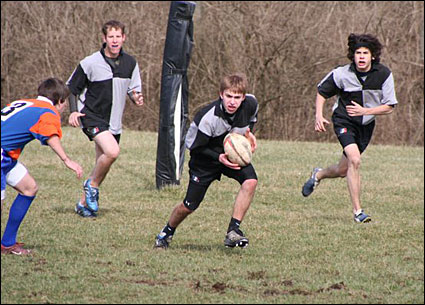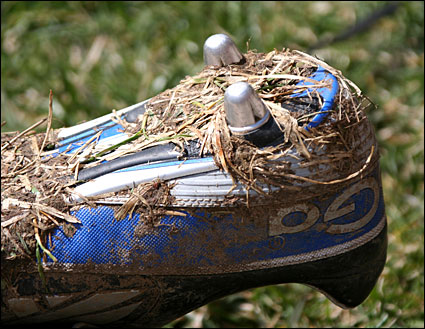Rugby: Is it being played wrong?
Posted By RichC on March 26, 2006
 I’ve waited a week to post my concerns about the sport of rugby which is growing quickly in the United States. (far more popular in other countries) My son is a sophomore and this is his first year on the team which is comprised of students from a couple different local high schools. Rugby is a physical game requiring an array of skills from endurance, physical ‘beastliness’ and as well as practice and conditioning — which may not be sufficient. After the first two matches, the three teams involved has had, ‘in my opinion’ too many severe injuries: 4 broken legs, a broken arm, 17 stitch cut along with the usual bruises, sprains, strains, small cuts and bloodied noses. All of this in two matches mind you, so I’m not the only parent showing concern.
I’ve waited a week to post my concerns about the sport of rugby which is growing quickly in the United States. (far more popular in other countries) My son is a sophomore and this is his first year on the team which is comprised of students from a couple different local high schools. Rugby is a physical game requiring an array of skills from endurance, physical ‘beastliness’ and as well as practice and conditioning — which may not be sufficient. After the first two matches, the three teams involved has had, ‘in my opinion’ too many severe injuries: 4 broken legs, a broken arm, 17 stitch cut along with the usual bruises, sprains, strains, small cuts and bloodied noses. All of this in two matches mind you, so I’m not the only parent showing concern.
I decided to talk to internet friends and search statistics on Rugby. It was sort of a fishing expedition into what is normal and abnormal, yet I still couldn’t find numbers to quantify participation and injuries like I wanted. In talking to college age intermural rugby players, the first thing I found out was that there was an immediate concern from all I talked to with the number of broken bones in our first two matches. A 3rd year medical student who played rugby 3 of his undergrad years indicated that concern for his health when he was finally accepted into med school was a reason to sit out his senior year — he had too much to risk. Others had played throughout their college years and couldn’t recall anyone with a broken leg or having to call the rescue squad. Interestingly last week, the rescue squad came 3 times — the final time they sent the ladder firetruck since the rescue squads were still returning from the prior calls.
In the same vein, the players that I talked to overseas indicated a very similar story. One English ‘chap’ had played a six years without seeing this kind of carnage. He was quick to point out that the game is physical, but that sportmanship, coaching and attentive referees usually maintain game control and they should stop illegal play and dangerous hits. He pointed out that the physical conditioning of our teams might not be as tailored to rugby as it needs to be.
The biggest concern for players of rugby are for injuries to the head, particularly for those not wearing head protection. Statistics state 25% of serious rugby injuries are to the head (1). (only two out of 60 players had head protection last week) According to the Department of Physical Medicine and Rehabilitation, Indiana University Medical Center, “rugby players should be encouraged to use the limited protective gear that is allowed: wraps, tape, joint sleeves, scrum caps, and facial grease to prevent lacerations. Mouthguards are strongly recommended at any level of play and should be mandated.” Another concern is that of proper coach preparation that stresses the conditioning of players. “Coaches should be experienced and attend clinics or complete video courses on medical emergencies and safe techniques of the game. Injury frequency and severity can be decreased by adequate preseason training and conditioning, proper tackling and falling techniques, strengthening of neck muscles, and allowing only experienced, fit athletes to play in the front row.”
The concern is enough that The United States Rugby Football Foundation on January 9, 2006 granted $14,000 to study safety in high school rugby. An immediate concern to me as a parent is that the Rugby Foundation’s earlier finding was that “5% of the injuries sustained in matches were attributed directly to action that was ruled illegal activity/foul play by a referee or disciplinary committee. While referees are responsible for penalizing foul play on the field, a commitment should be made by coaches, parents, and athletes to eliminate this avoidable injury risk from the game.”
After the number and severity of injuries in the first two games, I was particularly attentive to both teams this week. Frankly, from a spectators perspective, I was not able to see anything that looked unsportsmanlike in this weekend’s match. Both teams played hard although not necessarily well. (we lost but the match was without major injury) Nevertheless, I’ve made my parenting rounds and noted concerns from other parents as well since two of the broken legs were on our team. One player continues to be on pain medicine and is still in the hospital a week after his snapped leg.
There was a time I enjoyed watching my son compete in sports … win or lose … it was fun. Now I find myself more concerned that there will be another serious injury. Thankfully so far for Taylor, he generally just comes home caked in mud (and blood, most from his own nose) and complaining only that he is sore, bruised or was stepped on with those metal cleats (2)! (also I’m going to start covering my car seats in plastic.)

On a side note, in the US, American style football has put an extraordinary focus on safety and improving the gear in protecting players. As a comparison I would be curious as to what kind of thought is giving to high school and college rugby safety by those administrators who oversee safety of student athletes?
Comments